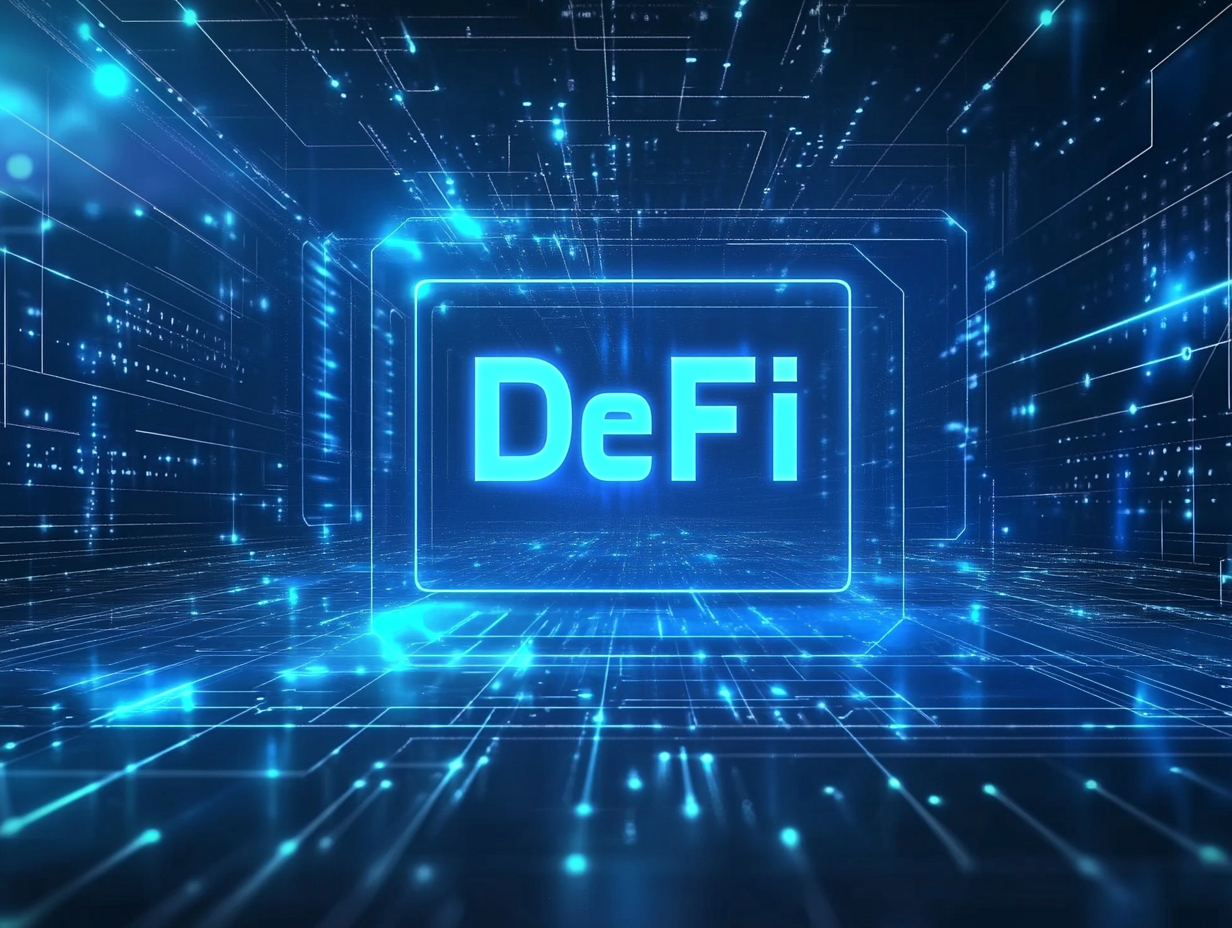Top 5 Risks in DeFi Lending and How to Manage Them

The Rise of DeFi Lending and Its Challenges
By implementing innovative solutions powered by blockchain technology, Decentralized Finance (DeFi) is transforming the financial services sector. Among its key innovations, DeFi lending has emerged as a fundamental component, allowing DeFi protocols to provide effortless access to loans and investments without the need for intermediaries. These DeFi applications enable borrowers and lenders to engage directly by using digital assets as collateral.
However, the rapid rise of DeFi lending comes with its own challenges. We will examine the five main risks, ranging from borrower defaults to platform weaknesses, and talk about practical strategies for risk management. Grasping these risks is crucial when engaging with the blockchain-based DeFi ecosystem.
1) Volatility Risks
How Borrowers are Impacted by Market Fluctuations
A significant challenge in DeFi lending protocols is the intrinsic volatility of crypto assets utilized as collateral. Borrowers often use assets like ETH or BTC as collateral in lending pools, but sudden market drops can sharply reduce their value. Should the value fall beneath the necessary threshold, liquidations occur, resulting in considerable losses for borrowers.
For example, in the 2022 crypto market crash, the significant drop in major cryptocurrency assets triggered extensive liquidations on DeFi platforms such as Aave and Compound. Borrowers who couldn't maintain their collateral faced liquidation, highlighting the importance of proactive risk management.
How to Mitigate Volatility Risks
- Utilize Stablecoins: Use stablecoins as collateral to minimize exposure to price fluctuations.
- Track Collateral Ratios: Keep collateral significantly above liquidation limits to provide a safeguard against market volatility.
- Stay Up: Use real-time analytical tools offered by DeFi protocols to track collateral status and prevent liquidation incidents.
2) Smart Contract Risks
The Foundation of Blockchain-Powered DeFi
Smart contracts form the foundation of DeFi applications, automating tasks like loan contracts, collateral handling, and repayments. By eliminating the necessity for middlemen, these open-source tools simplify financial transactions and allow for open access. Yet, smart contracts carry risks—errors or vulnerabilities in their code can lead to significant financial losses.
An important instance is the 2020 bZx exploit, which revealed significant vulnerabilities in DeFi protocols and led to the loss of almost $1 million. Events like this highlight the necessity of secure, thoroughly examined blockchain systems in DeFi lending.
Ways to Reduce Risks in Smart Contracts
- Choose Audited Platforms: Focus on DeFi protocols that receive thorough third-party audits to uncover and address weaknesses in their smart contract code.
- Diversify Investments: Distribute your capital over several platforms to reduce the risks linked to any one system.
- Engage Reliable Platforms: Use well-known DeFi platforms such as Aave and MakerDAO, recognized for their strong security protocols and histories.
3) Liquidity Risks
The Role of Lending Pools and Liquidity Pools
Lending pools and liquidity pools are essential to DeFi lending, effortlessly linking lenders with borrowers. Although lending pools make it possible to create loans, liquidity pools offer the capital reserves needed to ensure the platform runs smoothly. Nonetheless, these systems may encounter substantial difficulties during liquidity shortages resulting from abrupt withdrawals, decreased participation, or market downturns. When liquidity diminishes, borrowers might find it difficult to refinance loans, and lenders may encounter delays in retrieving their funds.
A significant instance was the collapse of the Terra ecosystem, which caused major liquidity shortages. Borrowers depending on UST-backed lending pools encountered major difficulties as liquidity vanished, revealing the weaknesses of precarious liquidity pools.
4) Regulatory Risks
DeFi Lending and the Evolving Legal Environment
The swift growth of DeFi lending has captured the interest of regulators worldwide. Authorities and regulatory entities are progressively examining blockchain-driven financial systems, implementing measures that include limitations on lending options and more rigorous tax enforcement. These actions can directly affect DeFi platforms, diminish user profitability, and create compliance issues for crypto holders.
A prominent case is BlockFi, which encountered a $100 million penalty from the U.S. SEC in 2021 for failing to register its lending offerings. This emphasizes that even top DeFi protocols are subject to regulatory risks, highlighting the necessity of being informed and proactive.
How to Manage Regulatory Challenges
- Understand Local Regulations: Get to know the legal context regarding crypto assets, decentralized applications, and blockchain technology in your area.
- Keep Detailed Records: Maintain an orderly account of your lending transactions, borrowed amounts, and taxable occurrences to ensure adherence and ease audits.
- Choose Compliant Platforms: Choose DeFi platforms and protocols that work closely with regulators and emphasize compliance, minimizing your legal risk exposure.
5) Platform Risks
Security and Trust in DeFi Lending
Not all DeFi lending protocols emphasize transparency or strong security protocols, resulting in considerable risks associated with the platforms. Problems like rug pulls or security violations can result in significant monetary losses. A significant instance is the 2021 Poly Network breach, in which cybercriminals took advantage of weaknesses to siphon off more than $600 million. Although the majority of funds were eventually restored, the event highlights the essential necessity of assessing the security and trustworthiness of DeFi platforms.
Strategies to Alleviate Platform Risks
- Conduct Thorough Research: Examine the platform's team, security evaluations, and community opinions to evaluate its trustworthiness.
- Start Small: Initiate with small investments to assess the platform's security and performance.
- Choose Reputable Platforms: Focus on well-known entities such as Aave, Compound, and MakerDAO, recognized for their reliable history and robust security measures in the DeFi ecosystem.
General Risk Management Strategies
To address the interconnected risks in DeFi lending, consider adopting these proactive strategies:
- Diversify Investments: Allocate funds across various platforms and asset types to minimize exposure to single-point failures.
- Stay Informed: Keep track of developments in blockchain technology, market dynamics, and changing regulatory environments to make informed choices.
- Opt for Audited Protocols: Pick decentralized lending protocols that have received thorough security audits to minimize the chances of exploits.
- Monitor TVL and Activity: Consistently observe metrics such as total value locked (TVL), liquidity amounts, and collateral ratios in real-time to anticipate possible problems.
Conclusion: Balancing Opportunity and Risk in DeFi Lending
DeFi lending has transformed the financial system, providing users with unique chances to generate passive income, obtain crypto loans, and utilize decentralized platforms. Nonetheless, these advantages come with a distinct array of challenges. Navigating the DeFi ecosystem demands careful attention and planning due to borrower defaults, liquidity shortages, smart contract weaknesses, regulatory ambiguities, and platform risks.
To investigate another revolutionary element of DeFi lending, check out our article on flash loans, an innovative resource that highlights both the strengths and possible downsides of decentralized finance. By broadening investment options, employing reliable and verified DeFi protocols, and keeping up with market trends and risks, users can maximize the benefits of decentralized exchanges while effectively managing risks.
Frequently Asked Questions
What risks are involved in DeFi lending?
DeFi lending carries risks like:
- Volatility risks: Collateral value fluctuations may trigger liquidations.
- Smart contract vulnerabilities: Code bugs or exploits.
- Liquidity shortages: Withdrawal difficulties during market downturns.
- Regulatory changes: Legal uncertainties impacting platforms.
How can I mitigate risks in DeFi lending?
To manage risks:
- Use stablecoins as collateral.
- Choose audited and reputable platforms like Aave or MakerDAO.
- Monitor collateral ratios and platform metrics such as Total Value Locked (TVL).
Is DeFi lending regulated?
DeFi lending operates in a legally evolving space. Some platforms work towards compliance with local regulations, while others remain decentralized and unregulated. Understanding your local laws is crucial.
How do DeFi lending platforms ensure security?
Reputable platforms conduct third-party audits to identify vulnerabilities in smart contracts. Additionally, platforms like Aave and MakerDAO have robust security protocols to protect user funds.


Comments ()